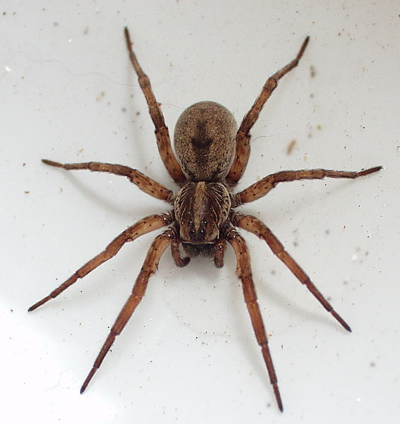FIND YOUR LOCAL
ARROW SERVICE CENTER
Lycosidae
More than 200 species of wolf spiders are native to North America, making these creatures a common sight in many American homes. Wolf spiders earned their name by stalking and hunting their prey before capturing them. Wolf spiders can get quite large and are easily identified by their furry appearance and two large round eyes surrounded by six smaller eyes.

| Color | Grayish-brown with lighter stripes |
| Legs | 8 |
| Shape | Large and fuzzy |
| Size | 1/4”- 2” |
| Antennae | False |
Despite their startling appearance, wolf spiders are not aggressive and will only bite when threatened or provoked. Wolf spiders are venomous, like all spiders, but wolf spider venom is not lethal to humans. Common symptoms of a wolf spider’s bite are swelling, mild pain, and itching.
Wolf spiders primarily eat small insects, including crickets, grasshoppers, earwigs, ants, and flies. These spiders are fast runners with excellent eyesight to hunt their prey instead of building a web to trap their prey.
Wolf spiders are nocturnal ground hunters and are found virtually anywhere there are insects for them to eat, including open fields, suburban backyards, and wooded areas. Wolf spiders can also live in wet habitats, such as coastal forests and near riverbanks in gravel beds. Wolf spiders will occasionally burrow in the ground for protection. When the weather turns cold, wolf spiders often seek warmer habitats and sometimes enter homes. They are typically found in garages and basements and around windows and doors.
You can get rid of wolf spiders that have moved indoors by vacuuming them up, setting up wolf spider traps with mouse or spider glue boards, or removing any clutter (especially cardboard boxes) where they may have made a nest. If your wolf spider problem is more focused outdoors, you can try sprinkling some boric acid around the infested area, which is not harmful to humans, but repels spiders - or eliminates them if ingested.
You can help prevent wolf spiders from entering a building by clearing vegetation around the perimeter of the building and removing yard debris such as wood, rock, and lumber piles. You should also seal all cracks or holes near the building's foundation and all gaps around windows and doors.
Additionally, having natural repellents around such as cedar, peppermint, eucalyptus, lavender, and lemongrass can help keep wolf spiders away. Keeping exterior lighting to a minimum can also be helpful, as light attracts the insects that wolf spiders like to hunt and eat.
In small numbers, wolf spiders can help control other pests. However, they can become a nuisance in large enough numbers. If you suspect you have a wolf spider infestation, get help from the professionals at Arrow Exterminators using the form below.
After you submit the information below, a trained professional in your area will get in touch within 1-2 business days to set up a date & time that is convenient for you.